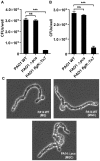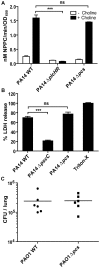Absence of membrane phosphatidylcholine does not affect virulence and stress tolerance phenotypes in the opportunistic pathogen Pseudomonas aeruginosa
- PMID: 22363496
- PMCID: PMC3281885
- DOI: 10.1371/journal.pone.0030829
Absence of membrane phosphatidylcholine does not affect virulence and stress tolerance phenotypes in the opportunistic pathogen Pseudomonas aeruginosa
Abstract
During growth in presence of choline, both laboratory and clinical Pseudomonas aeruginosa strains synthesize phosphatidylcholine (PC), and PC makes up ∼4% of the total membrane phospholipid content. In all the strains tested, PC synthesis occurred only when choline is provided exogenously. Mutants defective in synthesis of PC were generated in the strain backgrounds PAO1 and PA14. Minimum inhibitory concentration studies testing sensitivity of PC-deficient strains towards various antibiotics and cationic antimicrobial peptides revealed no differences as compared to wild-type strains. Mutants incapable of synthesizing PC were also found to be unaffected in motility and biofilm formation on abiotic surfaces, colonization of biotic surfaces and virulence in a mouse infection model. A global phenotypic microarray was further used to identify conditions wherein membrane PC may play a role of in P. aeruginosa. No culture conditions were identified wherein wild-type and PC-deficient mutants showed phenotypic differences. Membrane PC may serve a highly specific role during P. aeruginosa interactions with its eukaryotic hosts based on all the clinical strains tested retaining the ability to synthesize it during availability of choline.
Conflict of interest statement
Figures




Similar articles
-
Induction by cationic antimicrobial peptides and involvement in intrinsic polymyxin and antimicrobial peptide resistance, biofilm formation, and swarming motility of PsrA in Pseudomonas aeruginosa.J Bacteriol. 2008 Aug;190(16):5624-34. doi: 10.1128/JB.00594-08. Epub 2008 Jun 13. J Bacteriol. 2008. PMID: 18556795 Free PMC article.
-
Multifunctional Acidocin 4356 Combats Pseudomonas aeruginosa through Membrane Perturbation and Virulence Attenuation: Experimental Results Confirm Molecular Dynamics Simulation.Appl Environ Microbiol. 2020 May 5;86(10):e00367-20. doi: 10.1128/AEM.00367-20. Print 2020 May 5. Appl Environ Microbiol. 2020. PMID: 32169940 Free PMC article.
-
Pseudomonas aeruginosa-plant root interactions. Pathogenicity, biofilm formation, and root exudation.Plant Physiol. 2004 Jan;134(1):320-31. doi: 10.1104/pp.103.027888. Epub 2003 Dec 30. Plant Physiol. 2004. PMID: 14701912 Free PMC article.
-
Novel drug targets in cell wall biosynthesis exploited by gene disruption in Pseudomonas aeruginosa.PLoS One. 2017 Oct 18;12(10):e0186801. doi: 10.1371/journal.pone.0186801. eCollection 2017. PLoS One. 2017. PMID: 29045498 Free PMC article.
-
Effects of subinhibitory concentrations of macrolide antibiotics on Pseudomonas aeruginosa.Chest. 2004 Feb;125(2 Suppl):62S-69S; quiz 69S. doi: 10.1378/chest.125.2_suppl.62s. Chest. 2004. PMID: 14872002 Review.
Cited by
-
Cellular choline and glycine betaine pools impact osmoprotection and phospholipase C production in Pseudomonas aeruginosa.J Bacteriol. 2012 Sep;194(17):4718-26. doi: 10.1128/JB.00596-12. Epub 2012 Jun 29. J Bacteriol. 2012. PMID: 22753069 Free PMC article.
-
ExoS/ChvI Two-Component Signal-Transduction System Activated in the Absence of Bacterial Phosphatidylcholine.Front Plant Sci. 2021 Jul 23;12:678976. doi: 10.3389/fpls.2021.678976. eCollection 2021. Front Plant Sci. 2021. PMID: 34367203 Free PMC article.
-
Neurotransmitter acetylcholine mediates the mummification of Ophiocordyceps sinensis-infected Thitarodes xiaojinensis larvae.Appl Environ Microbiol. 2024 Sep 18;90(9):e0033324. doi: 10.1128/aem.00333-24. Epub 2024 Aug 7. Appl Environ Microbiol. 2024. PMID: 39109874 Free PMC article.
-
Control of biofilm-producing Pseudomonas aeruginosa isolated from dairy farm using Virokill silver nano-based disinfectant as an alternative approach.Sci Rep. 2022 Jun 8;12(1):9452. doi: 10.1038/s41598-022-13619-x. Sci Rep. 2022. PMID: 35676412 Free PMC article.
-
Membrane lipids in Agrobacterium tumefaciens: biosynthetic pathways and importance for pathogenesis.Front Plant Sci. 2014 Mar 26;5:109. doi: 10.3389/fpls.2014.00109. eCollection 2014. Front Plant Sci. 2014. PMID: 24723930 Free PMC article. Review.
References
-
- Henry SA, Patton-Vogt JL. Genetic regulation of phospholipid metabolism: Yeast as a model eukaryote. Prog Nucleic Acid Res Mol Biol. 1998;61:133–179. - PubMed
-
- Exton JH. Phospholipase D: Enzymology, mechanisms of regulation, and function. Physiol Rev. 1997;77:303–320. - PubMed
-
- Exton JH. Phosphatidylcholine Breakdown and Signal-Transduction. Biochim Biophys Acta. 1994;1212:26–42. - PubMed
-
- Aktas M, Wessel M, Hacker S, Klusener S, Gleichenhagen J, et al. Phosphatidylcholine biosynthesis and its significance in bacteria interacting with eukaryotic cells. Eur J Cell Biol. 2010;89:888–894. - PubMed
-
- Martinez-Morales F, Schobert M, Lopez-Lara IM, Geiger O. Pathways for phosphatidylcholine biosynthesis in bacteria. Microbiology. 2003;149:3461–3471. - PubMed
Publication types
MeSH terms
Substances
Grants and funding
LinkOut - more resources
Full Text Sources
Molecular Biology Databases

